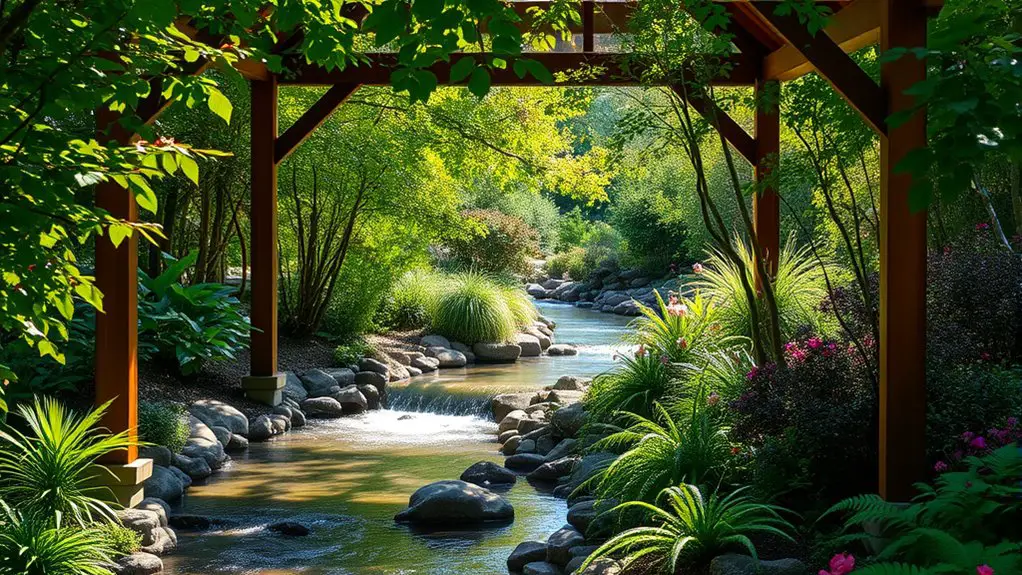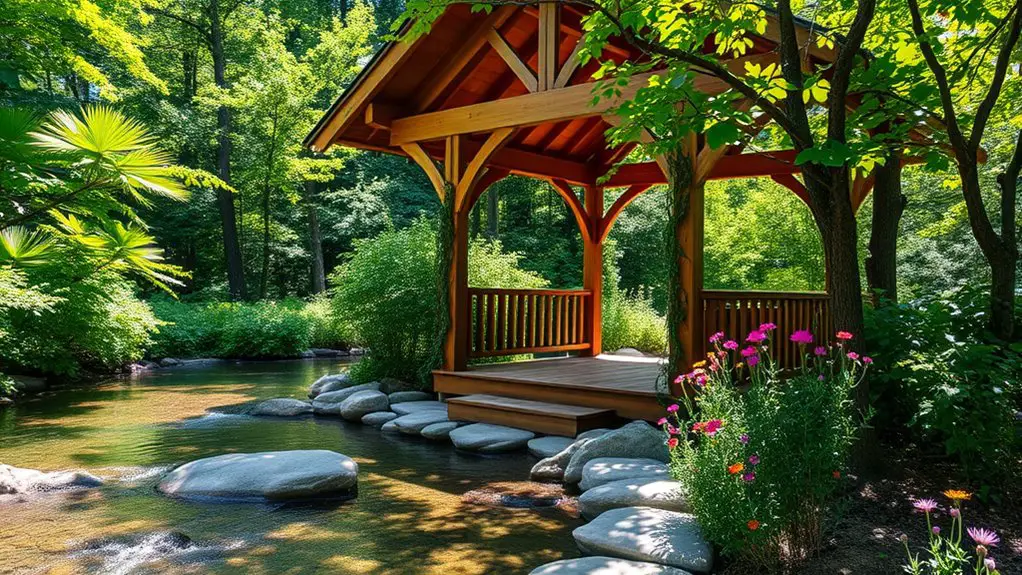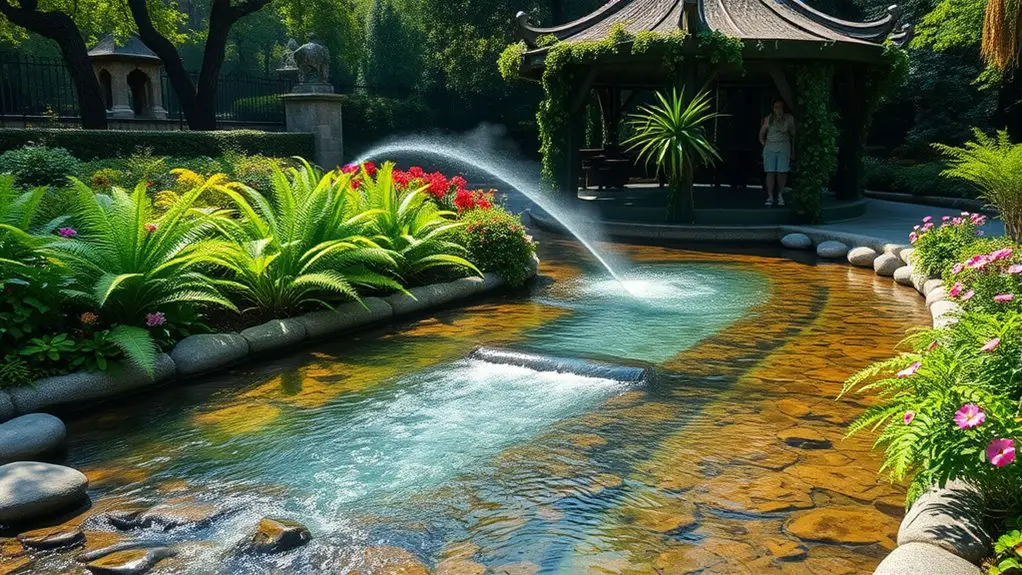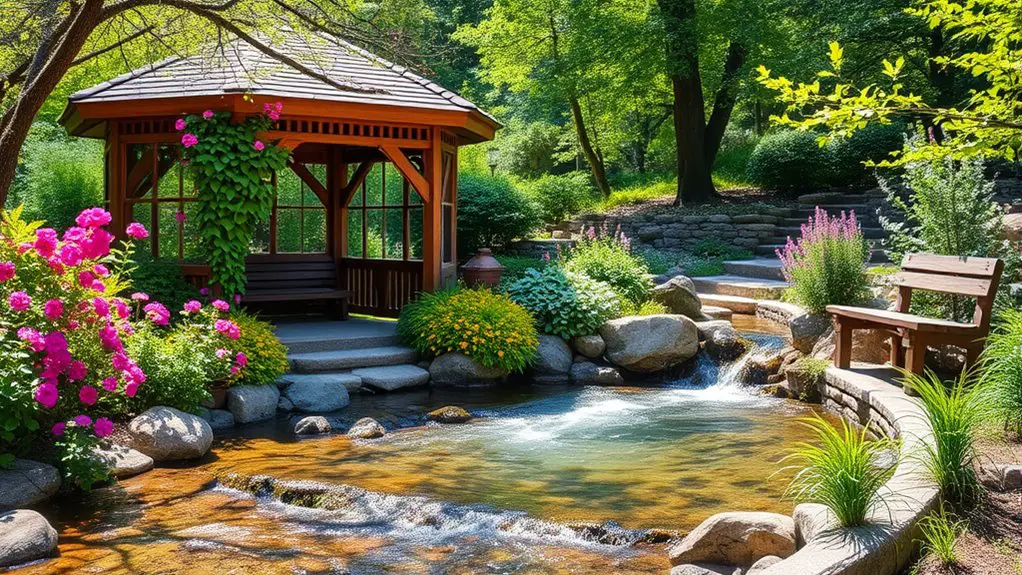To incorporate a stream into your gazebo garden, start by evaluating your garden’s dimensions and natural slopes for ideal water flow. Design gentle curves for a natural feel and choose durable materials like stone or eco-friendly options. Landscape with native plants for harmony and aesthetics. Guarantee proper water flow with suitable pumps and incorporate features like fountains. Create inviting seating areas and maximize views from the gazebo. You’ll discover even more tips to enhance your garden experience.
Assessing Your Garden Space for a Stream

When you’re considering adding a stream to your gazebo garden, it’s crucial to evaluate your space carefully. Start by determining the dimensions of your garden; this will influence your stream’s location and overall design. Look for natural slopes or low areas where water can flow gracefully, enhancing both aesthetics and functionality.
Next, think about how the stream will interact with your gazebo. Aim for a location that invites relaxation while providing soothing sounds of water. Consider factors like sunlight and shade, as well as proximity to existing plants, to guarantee harmony in your garden ecosystem.
Don’t forget to plan for maintenance access; a well-placed stream should be easy to care for without disrupting your garden’s layout. Balancing these elements will help you create a tranquil retreat that celebrates the beauty of nature while granting you the freedom to unwind in your personal oasis.
Designing the Stream Layout
When designing your stream layout, start by evaluating the available space to guarantee it complements your gazebo garden’s overall aesthetic. Next, determine the flow direction; this will guide the natural movement of water and enhance the visual appeal. Finally, choose materials wisely to create a harmonious and functional stream that blends seamlessly with your garden environment.
Assess Available Space
Evaluating the available space is essential for designing your stream layout, as it determines how seamlessly the water feature integrates into your gazebo garden. Begin with a thorough space evaluation, measuring your garden dimensions to understand where the stream can flourish. Consider the contours of the land; a natural slope can enhance movement and sound. Look for existing plants, structures, or pathways that might influence your design. Sketch potential stream paths, allowing for curves and bends that mimic nature, while ensuring they don’t obstruct access to your gazebo. Remember, a well-planned layout balances aesthetics and functionality, creating a harmonious environment where you feel free to relax and enjoy the beauty of your outdoor space.
Determine Flow Direction
How can you guarantee that your stream flows naturally within your gazebo garden? Start by observing the existing landscape and identifying natural flow patterns. You’ll want to design your stream to mimic these natural routes, allowing for seamless water circulation. Consider the elevation changes; water should flow downhill, creating a sense of movement and life. Use gentle curves and meanders to enhance visual appeal while ensuring the stream doesn’t feel forced. Incorporate features like small rocks or plants to guide the water’s path, creating pockets of calm and turbulence. By respecting the land’s contours, you’ll foster a harmonious relationship between your stream and garden, empowering nature to dictate the flow and rhythm of your outdoor oasis.
Choose Materials Wisely
Choosing the right materials for your stream is essential, as they not only affect its durability but also influence the overall aesthetic of your gazebo garden. Opt for durable materials like natural stone or reinforced concrete for the streambed; these options withstand weather changes and guarantee longevity. For the banks, consider eco-friendly options like reclaimed wood or bamboo, which blend beautifully with nature and promote sustainability. If you’re adding a pump, choose energy-efficient models that minimize environmental impact while providing reliable water flow. Incorporate gravel or pebbles for drainage and visual interest. By carefully selecting these materials, you’ll create a harmonious and resilient stream that enhances your garden’s beauty and functionality, allowing you to enjoy a serene outdoor sanctuary.
Choosing the Right Materials
Selecting the right materials is essential for the success and longevity of your gazebo garden stream. You’ll want to prioritize material durability to withstand the elements and guarantee your stream remains functional and visually appealing. Consider using natural stone for the streambed; it not only blends beautifully with the garden but also provides a sturdy, lasting foundation. For the lining, opt for eco-friendly options like recycled rubber or biodegradable materials, which minimize environmental impact while effectively preventing soil erosion. When it comes to pumps and filtration systems, invest in energy-efficient models to keep your stream clean without straining your energy resources. Additionally, ensuring that your materials are weather resistant will further enhance the longevity of your stream. Lastly, choose plant materials that thrive in moist conditions, ensuring a vibrant ecosystem. By selecting the right components, you can create a serene, sustainable oasis that enhances your gazebo garden and reflects your commitment to nature.
Incorporating Natural Elements

To create a harmonious gazebo garden, selecting native plants is essential, as they’ll thrive in your local climate and support local wildlife. Incorporating natural pathways not only enhances accessibility but also encourages exploration and interaction with your garden’s features. By thoughtfully integrating these elements, you’ll foster a serene and inviting atmosphere that complements your stream beautifully.
Selecting Native Plants
When you incorporate native plants into your gazebo garden, you’ll not only enhance its natural beauty but also create a thriving ecosystem that supports local wildlife. Here are some key native plant benefits you’ll enjoy:
- Attract Pollinators: Native blooms draw bees, butterflies, and other pollinators, boosting local biodiversity.
- Resilience: These plants are adapted to your region’s climate, requiring less water and maintenance.
- Soil Health: Native roots help stabilize soil, reducing erosion and improving nutrient cycling.
- Wildlife Habitat: They provide food and shelter for birds, insects, and other wildlife, fostering a vibrant ecosystem.
Designing Natural Pathways
As you envision pathways weaving through your gazebo garden, consider how natural elements can enhance both aesthetics and functionality. Using natural materials like gravel, stone, or reclaimed wood not only blends seamlessly with your environment but also provides a sustainable choice. Think about varying textures and colors to create visual interest while ensuring durability. Integrate pathway lighting to guide your way during evening gatherings; solar-powered lights can illuminate these paths without detracting from the natural ambiance. Strategically position lights to highlight the surrounding flora, creating a magical atmosphere. Additionally, consider gentle curves in your design to evoke a sense of exploration, inviting visitors to meander through your serene landscape while enjoying the sights and sounds of nature.
Selecting Plants for Streamside Landscaping
Selecting the right plants for streamside landscaping can transform your gazebo garden into a serene oasis. When choosing streamside flora, you’ll want to take into account both aesthetics and functionality. Here are four essential plant types to take into account:
Choosing the right streamside plants enhances your gazebo garden’s beauty and functionality, creating a tranquil retreat.
- Aquatic Plants: Introduce species like water lilies or lotus for stunning blooms and natural filtration.
- Marginal Plants: Opt for plants such as cattails or rushes that thrive in wet soil, creating a lush border.
- Ground Covers: Use creeping thyme or wild ginger to prevent erosion while adding texture.
- Tall Grasses: Incorporate ornamental grasses like Japanese blood grass for height and movement, enhancing visual interest.
Adding Water Features and Focal Points

Incorporating water features into your gazebo garden not only enhances its beauty but also creates a peaceful atmosphere. Consider various water feature types, such as fountains, ponds, or bubbling rocks, to introduce movement and sound. A fountain can serve as a stunning centerpiece, while a pond offers a natural habitat for aquatic plants and wildlife.
When designing your focal point, think about positioning the water feature to draw the eye from the gazebo. You might place a small pond adjacent to the seating area, surrounded by lush plants that frame the view. Incorporate elements like stepping stones leading to the water, creating an inviting pathway. Additionally, consider using string lights to create a magical ambiance around the water feature, enhancing the overall aesthetic of the garden.
Lighting plays a vital role; soft illumination can accentuate the water’s surface and surrounding flora at night. By thoughtfully selecting water features and applying focal point design, you’ll cultivate a harmonious space that invites relaxation and contemplation in your gazebo garden.
Ensuring Proper Water Flow and Maintenance
While the aesthetic appeal of a stream in your gazebo garden is undeniable, ensuring proper water flow and maintenance is essential for its longevity and functionality. To create a sustainable water feature, consider these key elements:
The beauty of a garden stream is enhanced by proper maintenance and water flow for lasting enjoyment.
- Pump Selection: Choose a pump that matches your stream’s size to maintain ideal water circulation.
- Regular Cleaning: Clear debris and algae regularly to prevent blockages that hinder flow.
- Water Quality Testing: Monitor pH and clarity; maintaining water quality promotes a healthy environment.
- Seasonal Adjustments: Adapt your maintenance routine with the changing seasons, ensuring the stream remains functional year-round.
Attracting Wildlife to Your Stream
A vibrant stream in your gazebo garden can transform the space into a haven for various wildlife. To attract birds, consider placing bird feeders strategically near the stream. Choose feeders filled with seeds that entice local species, such as sunflower seeds for finches or suet for woodpeckers. The flowing water provides essential hydration, making your garden more appealing.
Creating diverse wildlife habitats is equally important. Incorporate native plants along the stream’s banks to provide shelter and food for small mammals and insects. Consider adding rocks and logs to create natural hiding spots. These elements not only enhance the stream’s aesthetics but also establish a balanced ecosystem.
Creating Seating Areas Near the Stream
When creating seating areas near your stream, it’s essential to choose comfortable seating options that invite relaxation. Consider the placement of your seating to enhance views of the water while ensuring privacy with natural screens like shrubs or trees. This thoughtful arrangement will transform your gazebo garden into a tranquil retreat, allowing you to fully enjoy the soothing sounds of flowing water.
Choosing Comfortable Seating Options
Creating inviting seating areas near your stream not only enhances the aesthetic of your gazebo garden but also encourages relaxation and connection with nature. To craft the perfect spot, consider these options:
- Stylish Benches: Opt for weather-resistant materials that blend seamlessly with your garden’s vibe.
- Comfortable Cushions: Choose plush, outdoor-friendly cushions to invite lounging and long conversations.
- Rocking Chairs: Add a touch of nostalgia with rocking chairs, perfect for gentle swaying while listening to the water flow.
- Hammocks: For ultimate freedom, hang a hammock nearby, allowing you to sway amid nature’s beauty.
Enhancing Views With Placement
To truly appreciate the soothing sounds and sights of your stream, thoughtful placement of seating areas is essential. Position your seating to maximize scenic perspectives, ensuring that each spot offers a unique view of the water’s gentle flow. Consider placing chairs or benches along the banks, allowing you to engage with the stream visually while enjoying its calming presence. Varying the heights of seating can enhance visual interest, creating layers that draw the eye across the landscape. Incorporate natural materials like wood or stone to harmonize with the environment, reinforcing a sense of freedom and connection. Strategically placed seating not only invites relaxation but also transforms your gazebo garden into a tranquil retreat, where the beauty of nature is always within reach.
Adding Natural Privacy Screens
While you may want to enjoy the calming presence of the stream, ensuring your seating areas offer a sense of seclusion enhances the overall experience. To create natural privacy screens, consider incorporating the following elements:
- Dense privacy plants: Choose tall, bushy varieties like arborvitae or holly to block sightlines effectively.
- Layered planting: Combine low shrubs with taller trees to create a natural barrier that adds depth to your garden.
- Reed or bamboo screens: These can serve as flexible, eco-friendly partitions while complementing the stream’s aesthetic.
- Strategic positioning: Place seating areas behind natural barriers, fostering an intimate atmosphere where you can unwind and connect with nature.
Enhancing the Gazebo With Stream Views
Integrating a stream into your gazebo garden not only enhances the aesthetic appeal but also creates a serene atmosphere that invites relaxation. The flowing water provides a backdrop that fosters tranquility, while the sound of the stream enhances the gazebo harmony. Position your gazebo strategically to maximize these stream aesthetics. Additionally, a comfortable space can be created by incorporating seating arrangements that allow for views of the stream.
Here’s a quick guide to contemplate:
| Element | Importance |
|---|---|
| View Orientation | Guarantees optimum visuals from the gazebo |
| Plant Selection | Complements stream with native flora |
| Seating Arrangement | Enhances interactive experience |
Frequently Asked Questions
What Is the Ideal Size for a Garden Stream?
When envisioning your serene escape, consider a garden stream that’s about 12 inches deep and 2 feet wide. This creates a gentle flow, inviting tranquility while ensuring it’s easy to maintain and harmoniously fits your space.
How Much Does It Cost to Install a Stream?
When considering installation expenses for a stream, expect costs between $1,000 and $5,000, depending on size. Don’t forget about ongoing stream maintenance—keeping it clean and functional guarantees your investment flourishes harmoniously in nature.
Can I Use Recycled Materials for My Stream?
Absolutely, you can use recycled materials in your stream design! Items like reclaimed wood, stones, or even repurposed metal can create a unique, eco-friendly aesthetic while enhancing the natural beauty of your garden space.
How Do I Keep the Stream Clean and Algae-Free?
To keep your stream clean and algae-free, prioritize regular stream maintenance. Implement natural algae control methods like beneficial plants and aeration. Regularly remove debris and monitor water quality to guarantee a thriving, vibrant ecosystem.
What Wildlife Will a Stream Attract to My Garden?
A stream in your garden will attract various bird species, drawn by the water and surrounding aquatic plants. You’ll likely see vibrant butterflies and frogs, creating a lively ecosystem that enhances your garden’s beauty and tranquility.

